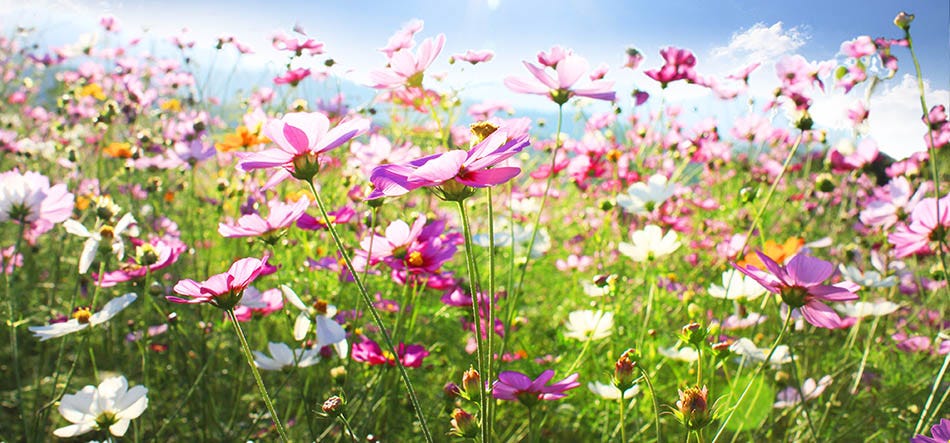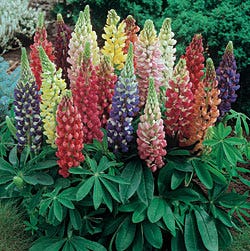The History of Wildflowers

The lovely flowering plants we all enjoy today were not around when our planet was much younger. In fact, how we arrived at the current botanical diversity we enjoy today is a fascinating story, and begins at the very beginning of time. Here's a layman's quick explanation of how it all happened.
Flowering plants are called Angiosperms. Their origins are still one of the great mysteries of evolution. Fossil records indicate they appeared suddenly on the planet about 80 to 90 million years ago, beginning their rapid diversification in the mid-Cretaceous epoch. Today angiosperms are the most abundant and diverse plants on the earth.
Originally, plants were generated from spores, not seeds.
The spore process is called sporophtye generation. In this process two types of spores are produced: microspores whose cell structure germinate and develop into males and megaspores which develop into females. This divergent development itself is called meosis. Plants evolved over time through sexual reproduction from these initial processes. In short, very early plants had all they needed to reproduce themselves. More advanced "flowering plants" did not. With their emergence, a whole new grand design was needed, and it required "outside help."
The birds and the bees.
Because plants are, for the most part, stationary or "non-locomotive" (which means they stay in one place rather than roaming around like animals or insects), nature had to provide a mechanism whereby the male and female parts of newly-formed flowers could reach each other safely and successfully. This need resulted in the rise of the system of pollination or fertilization by birds and insects. Flowers evolved into the showy, colorful forms we know and love to attract these pollinators. Sweet nectar simply added to the allure. Now you know the origin of the phrase, "the birds and the bees".
Though they are not the original landscaping of the planet, the history of flowering plants is long.
Archaeological evidence shows that early man knew of seeds 50,000 years ago, since their discovery in a cave in Northern Iraq. Excavations in the Nile Valley have shown the remains of 25 different plants, including cattails, dating to over 17,000 years ago. Chemical analysis done on Egyptian fabrics dating to 1370 BC show the presence of dyes extracted from plants of the madder family. Flower gardening scenes are depicted on the bedroom walls in the palace of Amenhotop IV circa 1380 BC, Ramses III is recorded as having imported and naturalized foreign plants: "Gardens of vines, of trees, fruits and flowers are around thy temple and before thy face."
The Greek and Roman contribution to horticulture
began with Theophrastus (300 BC) who is today considered the "Father of Botany". A pupil of Aristotle, he was put in charge of the Athenian botanical gardens which resulted in his work, De historia plantarum, a compilation of observations regarding trunks, inner plant structures, roots, leaves and seeds. He described about 500 separate plants using these criteria.
The Roman, Pliny (23 BC), studied ornamental and wild-growing plants based on their utility citing them as a source of food for both bees and man, as well as their potential medicinal uses. Even earlier, Virgil had described 164 plants including vetch and lupine in 50 BC. In 50 AD, the Greek, Dioscorides, known today as the "Father of Medicinal Botany" described 650 different species.
The Medieval Herbalists.
While the early Middle Ages produced little in the way of scientific plant content, Christian monasteries did preserve the works of antiquity which was later expanded upon by the so-called Herbalists. In 1530 Jacob Brunfels published the Herbarium Vical Eicones. In 1542 Leonhart Fuchs wrote his famous herbal, De Historia Stirpium.

In 1597 John Gerard published his famous Herbal of Generall Historie of Plants. And in 1624 Gaspard Bauhin published his Pinax Theatri Bonanici which classified about 6,000 species including hundreds of wildflowers using the concept of genus and species later formalized by Linnaeus, the brilliant Swedish botanist who organized it all.
Click here to read "How Wildflowers Got Their Names" which explains the naming system we use today, organized by Linnaeus.
The 17th through 19th centuries saw the rapid expansion of botany which was consistent with a period of exploration and scientific development. The 1700's witnessed the classification system of Linnaeus, and exchanges of plant specimens from the Americas to Europe through the travels of now-famous plant explorers such as Mark Catesby, who like many others, created exquisite drawings of the plants (and animals) he encountered. In the 1800's Lewis and Clark traveled the North American continent carefully noting its wild flora while Charles Darwin collected an enormous number of plants and published his Origin of the Species in 1859. Gregor Mendel introduced the science of genetics in 1866. Many of these botanical pioneers, including Lewis, Clark, and Darwin have their names immortalized in the botanical names of plants today.
The modern English/American fascination with wildflowers
As garden subjects really began in England with a few 19th Century gentlemen and gentlewomen, the most famous of which was surely Vita Sackville-West. These privileged people, quite accustomed to formalized flower beds tended by staffs of servants, became more and more interested in "natural" gardens, and the flowers that went with them. Gertrude Jekyll, the most famous English garden writer of the time, began cultivating what she called "flowering incidents" in her woodland and meadows. In involved either encouraging wildflowers she found "in situ", or creating new colonies by planting them in a naturalized manner.
Today's wildflower seed mixtures and the fascination with wildflower gardening is directly descended from these early English gardening innovators who recognized the flowers of the wild as perhaps the most wonderful and beautiful flowers of them all.